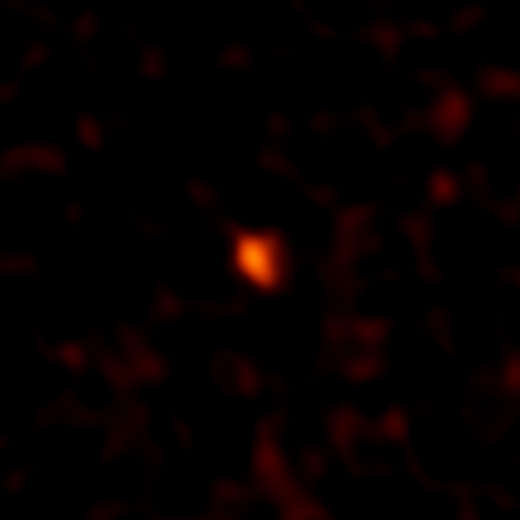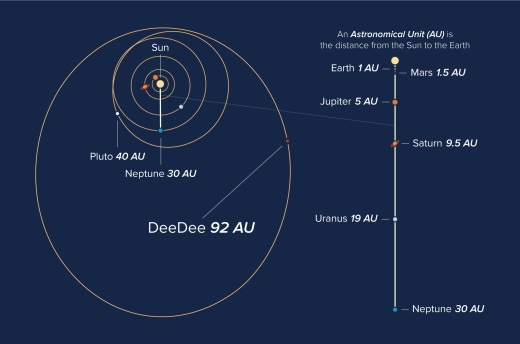Astronomical investigations can overlap in extremely helpful ways. Consider the Dark Energy Survey, which examines some 12 percent of the sky in an attempt to learn more about whatever force is accelerating the expansion of the universe. DES is trying to map hundreds of millions of galaxies and identify thousands of supernovae while looking for patterns in cosmic structure, using a 570-Megapixel digital camera, DECam, mounted on the Blanco 4-meter telescope at Cerro Tololo Inter-American Observatory (Chile).
What DES produces are thousands of images — its initial search uncovered 1.1 billion candidate objects, most of which are galaxies or background stars. But among the objects are some that move in successive observations, the signature of objects in our Solar System. David Gerdes (University of Michigan) was able to find what appears to be a dwarf planet within the dataset. Called 2014 UZ224 and informally known as DeeDee (for Distant Dwarf), the object has now been characterized in a new paper from Gerdes and team.

Image: ALMA image of the faint millimeter-wavelength “glow” from the planetary body 2014 UZ224, more informally known as DeeDee. Credit: ALMA (ESO/NAOJ/NRAO).
The data behind the paper come from observations using the Atacama Large Millimeter/submillimeter Array (ALMA), a radio telescope installation at about 5000 meters altitude in the Atacama desert of northern Chile. 2014 UZ224 turns out to be about 635 kilometers across, which makes it two-thirds the diameter of Ceres. This should make the object massive enough to be spherical, allowing it to be considered a dwarf planet. It is, in any case, an object in an area thought to be rich in trans-Neptunian objects:
“Far beyond Pluto is a region surprisingly rich with planetary bodies. Some are quite small but others have sizes to rival Pluto, and could possibly be much larger,” says Gerdes. “Because these objects are so distant and dim, it’s incredibly difficult to even detect them, let alone study them in any detail. ALMA, however, has unique capabilities that enabled us to learn exciting details about these distant worlds.”
The object orbits among a population that we are still learning how to categorize. Some trans-Neptunian objects are members of the scattered disk and inner Oort cloud population, reaching well beyond the Kuiper Belt to distances of hundreds of AU. DeeDee is now some 92 AU out in an orbit that would take more than 1100 years to complete (aphelion is at about 180 AU). Sedna, considered to be an extended scattered disc object (E-SDO), is now 86 AU from the Sun (aphelion 936 AU), while Eris is currently at 96.3 AU (aphelion 97.6 AU). The Minor Planet Center currently lists over 2000 objects in the overall category of TNOs.

Image: Orbits of objects in our Solar System, showing the current location of the planetary body 2014 UZ224. Credit: Alexandra Angelich (NRAO/AUI/NSF).
We can expect numerous TNO discoveries ahead, as the paper explains:
The population of detected TNOs is of course strongly biased toward those that are large, near perihelion, and/or have high albedo. Current surveys such as the DES now have the depth and area coverage to discover the counterparts of known objects that are well beyond perihelion. It is also noteworthy that the ALMA facility is easily capable of radiometric detection of a 600 km body at > 90 AU distance. Hence it will be possible to establish sizes and albedos for nearly every body detectable in the visible by DES and similar surveys. As these surveys progress, we will be able for example to determine whether the very high albedo of Eris is characteristic of large bodies at this distance, or whether flux selection has led to the first discovery being atypical.
Working at millimeter wavelengths, Gerdes and his fellow researchers were able to calculate that the surface of DeeDee is at a temperature of 30 Kelvin, not far above absolute zero. The object’s size could be calculated by comparing the ALMA observations to the optical information from DECam and the Blanco instrument at Cerro Tololo. The possible dwarf planet reflects about 13 percent of the sunlight that strikes it based upon its heat signature (according to this NRAO news release, that’s about the same reflectivity as a baseball infield).
The paper is Gerdes et al., “Discovery and Physical Characterization of a Large Scattered Disk Object at 92 AU,” Astrophysical Journal Letters Vol. 839, No. 1 (12 April 2017). Abstract / preprint.



The Australia “Stargazing” crowdsourcing effort to find Planet Nine ALSO turned up four new candidates. Just from the TONE of their press release, my take is they feel that they have probably NOT found Planet Nine per se(especially the quote: “we can now eliminate the possibility of a neptune sized planet out to…” approximately 1000 AU in their field of view. These candidates still could be Earth sized or at the boundary size for Super Earths or the SMALLEST kind of MINI-Neptune, but they will probably ALL be found to be objects SIMILAR to 2014 UZ224.
The most likely position for planet 9 is superposed to the galactic plane, so there is a lot of “noise”. There is a crowed project for that: https://www.zooniverse.org/projects/marckuchner/backyard-worlds-planet-9
The diameter of an asteroid needs in order to become round by gravity is six hundred kilometers. Deedee is close but probably round.
The density and composition are also important since a denser object will be allowed to have a smaller diameter so that self gravitation forces it to become spherical in shape. If its under a certain limit in size and mass it won’t be spherical.
CASE IN POINT: Enceladus! With a diameter of 504 Km, it is WAY BELOW the 600 Km threshold, but it is most decidedly round1
It will also depend on the size and number of hits as these can distort the shape by direct impact or having the object get extra rotation momentum.
If there is an ocean in Enceladus which means that it is easier to shape it into a sphere since water is not hard shape into a sphere. It depends what the asteroid is made for some materials are harder to shape into a sphere being more denser so that the 600 kilometer limit is not an absolute but can very depending on the chemical composition. In other words the sphere limit can be smaller for some materials.
Hydrogen has turned up in the plumes, which turn out to be about 98 percent water vapor and 1 percent hydrogen, with a mix of carbon dioxide, methane and ammonia making up the rest.”
Does anyone else find this odd? only 5 components in the plume? Where are the alkali and alkaline earths? No chlorides, or sulfates?
The instrument [Ion and Neutral Mass Spectrometer (INMS) ] was not designed for the ions you are mentioning. It isn’t a question of absence, just not being able to measure them.
See these refs for details:
1. The Cassini Ion and Neutral
Mass Spectrometer – INMS
2. Ion Neutral Mass Spectrometer Results
from the First Flyby of Titan
Thanks Alex, got it. Gas phase detection only.
There is the infra red spectrometer on Cassini which can measure Chlorides and sulfates but there might not be any in the plumes because the crust is composed of a layer of ice and water ocean between the rocky core. Its probably not big enough of a body for the heating of its interior by tidal heating or radio active decay to make volcanoes like on Io so none of the material in the core can be expelled.
Generally, the the lighter material is found in the outer solar system, the dwarf planets and Moons of the outer solar system like comets are composed of mostly ices, methane, ammonia etc like comets and denser, heavier material and silicates ares found in the inner solar system.
Cassini also has an ultraviolet spectrometer which can be used to detect the chemical composition of an atmosphere, plumes etc.
Our Discovery of a Minor Planet Beyond Neptune Shows There May Not Be ‘Planet Nine’ After All…
http://www.space.com/36561-minor-planet-beyond-neptune-and-planet-nine.html